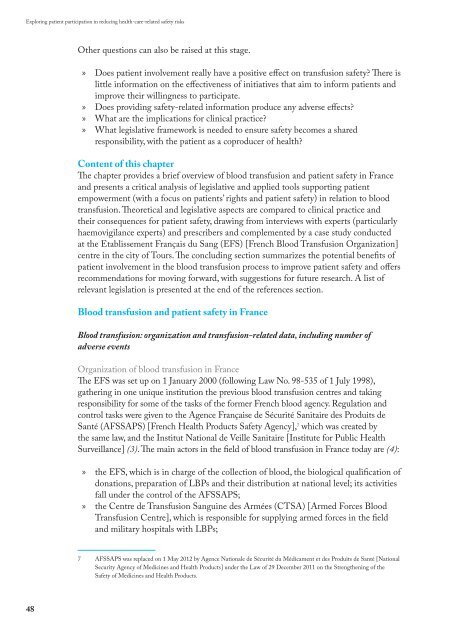Exploring patient participation in reducing health-care-related safety risks
Exploring patient participation in reducing health-care-related safety risks
Exploring patient participation in reducing health-care-related safety risks
You also want an ePaper? Increase the reach of your titles
YUMPU automatically turns print PDFs into web optimized ePapers that Google loves.
<strong>Explor<strong>in</strong>g</strong> <strong>patient</strong> <strong>participation</strong> <strong>in</strong> reduc<strong>in</strong>g <strong>health</strong>-<strong>care</strong>-<strong>related</strong> <strong>safety</strong> <strong>risks</strong><br />
48<br />
Other questions can also be raised at this stage.<br />
» Does <strong>patient</strong> <strong>in</strong>volvement really have a positive effect on transfusion <strong>safety</strong>? There is<br />
little <strong>in</strong>formation on the effectiveness of <strong>in</strong>itiatives that aim to <strong>in</strong>form <strong>patient</strong>s and<br />
improve their will<strong>in</strong>gness to participate.<br />
» Does provid<strong>in</strong>g <strong>safety</strong>-<strong>related</strong> <strong>in</strong>formation produce any adverse effects?<br />
» What are the implications for cl<strong>in</strong>ical practice?<br />
» What legislative framework is needed to ensure <strong>safety</strong> becomes a shared<br />
responsibility, with the <strong>patient</strong> as a coproducer of <strong>health</strong>?<br />
Content of this chapter<br />
The chapter provides a brief overview of blood transfusion and <strong>patient</strong> <strong>safety</strong> <strong>in</strong> France<br />
and presents a critical analysis of legislative and applied tools support<strong>in</strong>g <strong>patient</strong><br />
empowerment (with a focus on <strong>patient</strong>s’ rights and <strong>patient</strong> <strong>safety</strong>) <strong>in</strong> relation to blood<br />
transfusion. Theoretical and legislative aspects are compared to cl<strong>in</strong>ical practice and<br />
their consequences for <strong>patient</strong> <strong>safety</strong>, draw<strong>in</strong>g from <strong>in</strong>terviews with experts (particularly<br />
haemovigilance experts) and prescribers and complemented by a case study conducted<br />
at the Etablissement Français du Sang (EFS) [French Blood Transfusion Organization]<br />
centre <strong>in</strong> the city of Tours. The conclud<strong>in</strong>g section summarizes the potential benefits of<br />
<strong>patient</strong> <strong>in</strong>volvement <strong>in</strong> the blood transfusion process to improve <strong>patient</strong> <strong>safety</strong> and offers<br />
recommendations for mov<strong>in</strong>g forward, with suggestions for future research. A list of<br />
relevant legislation is presented at the end of the references section.<br />
Blood transfusion and <strong>patient</strong> <strong>safety</strong> <strong>in</strong> France<br />
Blood transfusion: organization and transfusion-<strong>related</strong> data, <strong>in</strong>clud<strong>in</strong>g number of<br />
adverse events<br />
Organization of blood transfusion <strong>in</strong> France<br />
The EFS was set up on 1 January 2000 (follow<strong>in</strong>g Law No. 98-535 of 1 July 1998),<br />
gather<strong>in</strong>g <strong>in</strong> one unique <strong>in</strong>stitution the previous blood transfusion centres and tak<strong>in</strong>g<br />
responsibility for some of the tasks of the former French blood agency. Regulation and<br />
control tasks were given to the Agence Française de Sécurité Sanitaire des Produits de<br />
Santé (AFSSAPS) [French Health Products Safety Agency], 7 which was created by<br />
the same law, and the Institut National de Veille Sanitaire [Institute for Public Health<br />
Surveillance] (3). The ma<strong>in</strong> actors <strong>in</strong> the field of blood transfusion <strong>in</strong> France today are (4):<br />
» the EFS, which is <strong>in</strong> charge of the collection of blood, the biological qualification of<br />
donations, preparation of LBPs and their distribution at national level; its activities<br />
fall under the control of the AFSSAPS;<br />
» the Centre de Transfusion Sangu<strong>in</strong>e des Armées (CTSA) [Armed Forces Blood<br />
Transfusion Centre], which is responsible for supply<strong>in</strong>g armed forces <strong>in</strong> the field<br />
and military hospitals with LBPs;<br />
7 AFSSAPS was replaced on 1 May 2012 by Agence Nationale de Sécurité du Médicament et des Produits de Santé [National<br />
Security Agency of Medic<strong>in</strong>es and Health Products] under the Law of 29 December 2011 on the Strengthen<strong>in</strong>g of the<br />
Safety of Medic<strong>in</strong>es and Health Products.



